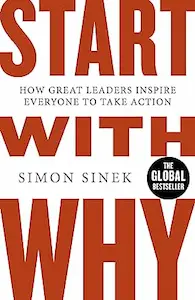Start With Why - Summary
Simon Sinek

Introduction
Simon Sinek’s book “Start With Why” is a powerful guide to understanding the importance of purpose in business and life. The book explores the idea that successful leaders and organizations start by identifying their “why” – their purpose, cause, or belief – before moving on to the “how” and “what” of their actions. By doing so, they are able to inspire and motivate others to follow their lead, creating a culture of trust, loyalty, and innovation.
The Golden Circle
At the heart of Sinek’s philosophy is the Golden Circle, a simple but powerful framework for understanding how great leaders inspire action. The Circle consists of three concentric rings: the outer ring represents “what” a company does, the middle ring represents “how” they do it, and the innermost ring represents “why” they do it.
According to Sinek, most companies and leaders start with the outer ring, focusing on the “what” of their products or services. This approach may be effective in the short term, but it fails to create a sense of purpose or connection with customers and employees. In contrast, the most successful leaders and organizations start with the innermost ring, the “why” of their mission, and use it to guide their actions and decisions.
The Power of Why
Sinek argues that starting with “why” is so powerful because it taps into the limbic system, the part of the brain responsible for emotions and decision-making. When people are inspired by a sense of purpose or belief, they are more likely to take action, make sacrifices, and stay loyal in the face of challenges.
One of the most compelling examples of this principle in action is Apple, a company that has consistently inspired a passionate following among its customers and employees. Sinek notes that Apple’s success is not just due to its innovative products, but to its clear and compelling sense of purpose: to challenge the status quo and empower individuals to think differently.
Leading with Why
Sinek also explores the role of leadership in creating a culture of purpose and inspiration. He argues that great leaders are those who are able to communicate their “why” in a way that inspires others to follow their lead. This requires a deep understanding of one’s own values and beliefs, as well as the ability to articulate them in a way that resonates with others.
One of the most powerful examples of this kind of leadership is Martin Luther King Jr., whose “I Have a Dream” speech is widely regarded as one of the most inspiring speeches in history. Sinek notes that King’s success was not just due to his charisma or rhetorical skill, but to his ability to articulate a clear and compelling vision of a better future, rooted in his deep sense of purpose and belief.
The Importance of Trust
Another key theme of Sinek’s book is the importance of trust in building successful organizations. He argues that trust is essential for creating a culture of innovation, collaboration, and risk-taking. When people trust their leaders and colleagues, they are more likely to take risks, share ideas, and work together to achieve common goals.
Sinek cites the example of Herb Kelleher, the founder of Southwest Airlines, who built a culture of trust and empowerment by treating his employees as partners rather than subordinates. By empowering his employees to make decisions and take ownership of their work, Kelleher created a culture of trust and loyalty that has helped Southwest become one of the most successful airlines in history.
Overcoming Obstacles
Sinek also acknowledges that starting with “why” is not always easy, especially in a world that often values short-term results over long-term vision. He notes that many leaders and organizations struggle to articulate their “why” or to stay true to it in the face of obstacles and challenges.
One example of this is the story of John F. Kennedy’s goal of putting a man on the moon. Sinek notes that Kennedy’s vision was not just about beating the Soviets in the space race, but about inspiring a sense of purpose and possibility in the American people. However, after Kennedy’s assassination, the goal lost its sense of purpose and became just another item on NASA’s to-do list.
Conclusion
In conclusion, “Start With Why” is a powerful and inspiring book that challenges readers to think deeply about their own sense of purpose and how it can be used to create positive change in the world. By starting with “why,” leaders and organizations can inspire others to follow their lead, create a culture of trust and innovation, and achieve lasting success. Whether you are a CEO, an entrepreneur, or simply someone looking to make a difference in the world, this book is a must-read.